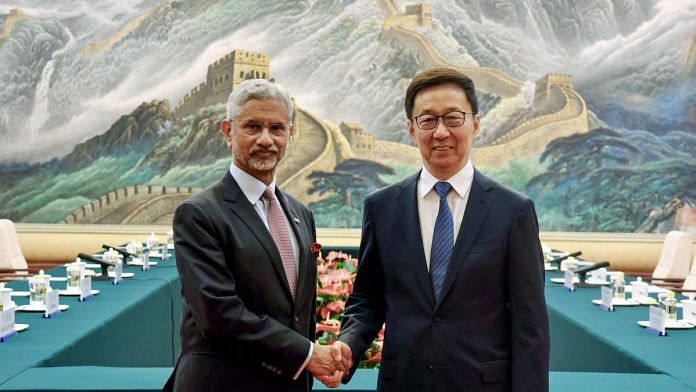Chinese media and online commentators are abuzz: Why did India’s External Affairs Minister, widely viewed as a “China hawk”, suddenly moderate his tone during his recent China visit? S Jaishankar’s visit, his first to China in five years, and the first since the 2020 Galwan clashes, was ostensibly for the Shanghai Cooperation Organisation Foreign Ministers’ Meeting. But to many Chinese observers, this was no routine diplomatic engagement.
The mood across Chinese policy circles and online platforms suggests that Beijing sees this as more than symbolic. Some interpret Jaishankar’s trip as a recalibration of India’s China policy; others view it as a tactical retreat driven by economic and strategic compulsions. Either way, the visit reflects the complex realities shaping India-China relations today.
An olive branch or economic necessity?
Much of the Chinese chatter frames India’s outreach as an olive branch. Jaishankar arrived in Beijing 72 hours ahead of the SCO meet and met Vice President Han Zheng, an unusual protocol break interpreted as urgency. On Weibo, the hashtag “Indian External Affairs Minister visits China after five years” sparked considerable discussion. One post bluntly read: ‘India appeared to act quickly in an effort to appease China.’
The optics were striking. Chinese Foreign Minister Wang Yi’s choice of meeting venue—the Fujian room of the Great Hall of the People, dominated by a mural of the Himalayas, was rich with symbolism. It served as a visual reminder that, while China is open to dialogue, its red lines [Line of Actual Control and Tibet] remain non-negotiable. A commentator mentioned that Jaishankar’s usual tough rhetoric was notably absent. His earlier warnings that neighbours must “obey or pay the price” gave way to calls for “dialogue”, “communication”, and mutual respect for “each other’s core interests”—this perceived shift was dismissed by online commentary as “second cowardice”, it viewed it as a sign of retreat rather than pragmatism.
Chinese analysts argue that Jaishankar’s early arrival was not just about diplomacy; it was a response to what they perceive as India’s triple anxiety: India’s rare earth crisis, breakdowns in shipping routes, and its waning influence in BRICS and the SCO. They also suggest that India’s economic vulnerabilities, especially in electronics and pharmaceuticals, are pushing it closer to China, despite geopolitical tensions. The speculation is that New Delhi may be hoping for a softening of China’s export restrictions on rare earth minerals in exchange for a more flexible Indian stance on multilateral issues. In this framing, what appears to be diplomacy is economic triage.
One commentator offers a bleak assessment of India’s position, arguing that Indian Prime Minister Narendra Modi’s balancing act between the US and China is unravelling, leaving India isolated within the SCO and exposing its “wall-rider” strategy as untenable. They described Jaishankar’s visit as “Modi’s life-saving straw,” a desperate attempt to salvage ties. Chinese critics contend that since the Trump administration, Washington has treated India more like a subordinate than a partner, pressuring it to purchase expensive US weapons. From this perspective, India is playing with the two powers, gaining little from either.
Also read: China’s information war against Rafale
Warnings and veiled threats
Chinese strategic voices are issuing veiled threats to India. Liu Zongyi, Director at the Centre for South Asian Studies in Shanghai, called India a “chronic internal cancer” within the SCO, accusing it of obstruction and opportunism. He urged Beijing to focus less on wooing Modi and more on reforming the organisation.
Xie Chao, Associate Research Fellow, Center for South Asian Studies, Fudan University, cautioned that India’s growing closeness with the US would only deepen friction with China, warning that the balancing act was “nearing its end.” Another commentator pointed to India’s stance on the China-Pakistan nexus and said the region could no longer afford old confrontations. “India has great opportunities, it should seize them wisely,” he wrote, in what read like both advice and a warning.
Jin Cangrong, a distinguished professor at Renmin University, accused India of harbouring hegemonic ambitions in South Asia and of clinging to a colonial mindset. Border dispute, he argued, stems not from Chinese aggression but from India’s historical delusions of grandeur. In a direct clash, Jin predicted, India would find itself outmatched—not militarily, but institutionally, hindered by weak reform and an outdated leadership class. “India can intimidate its smaller neighbours,” he said, “but China will not be bullied.”
Also read: Victor Gao claims all land north of Ganga for China. People say he’s a ‘diplomatic fighter’
A dismissal of Beijing’s outreach
Chinese discourse suggests that Modi’s China policy has fallen short of Delhi’s expectations. The fallout from the US-China tariff war has revealed the limits of aligning with the West. In this view, renewed engagement with China is not a diplomatic gesture but a strategic necessity, driven by both economic and geopolitical imperatives.
Jaishankar’s visit has been widely portrayed in Chinese discourse as a concession, reinforcing the image of China’s policy as righteous, muscular and unyielding. This narrative, however, overlooks Beijing’s own quiet overtures and the broader pressures informing India’s measured approach. It also underestimates the nuance of Indian foreign policy, which, despite its contradictions, is shaped by strategic interests, not submission, appeasement, or fear.
Sana Hashmi, PhD, is a fellow at the Taiwan-Asia Exchange Foundation. She tweets @sanahshmi. Views are personal.
(Edited by Theres Sudeep)







Consider the volume of merchandise trade, although imports greatly exceed exports. Continuing to grow despite tension in the relationship. India and China can do good business with each. Perhaps more investment flows in future as well. PM Albanese has paid a successful visit to China. So has PM Lawrence Wong . India and China have to learn to live together in peace. This troubled phase should draw to a close, with sincerity on both sides.